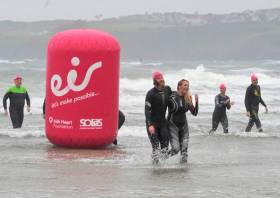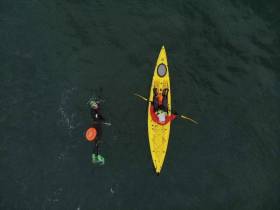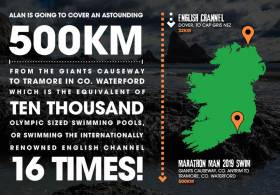Displaying items by tag: Alan Corcoran
After seven weeks and 500km of open water, ‘Marathon Man’ Alan Corcoran completed his epic swimming challenge from the Causeway Coast to Tramore on Monday morning, 22 July.
Sadly Alan wasn’t able to join supporters in the mass public swim organised to greet his arrival on Sunday, due to poor weather conditions that delated his approach along the Waterford coast.
But with some of those closet to him by his side, he wasted no time early on Monday by taking the first break in the weather at the crack of dawn to swim the final stretch from Ballymacaw to Tramore Strand.
“Four final hours of swimming and I can now proudly say, mission complete,” he wrote on his Facebook page where he’s been charing his adventure.
And Alan is still accepting donations for his chosen charities the Irish Heart Foundation and Solas Cancer Support Centre. See MarathonMan.co for more details.
‘Marathon Man’ Alan Corcoran has reached Howth and Dublin Bay, 36 days into his 500km open water swimming challenge from the Causeway Coast to Tramore.
As previously reported on Afloat.ie, Alan took on the mammoth task after completing an already ambitious run around the island of Ireland — and becoming the first man to do so — in 2012 tribute to his father, former FAI president Milo Corcoran.
A previous attempt at the long-distance swim in 2017 after his father’s death ended prematurely when his support boat sank, which only made Alan more determined to get it done this time around.
And he surpassed his previous efforts when he crossed the North-South border at Carlingford Lough last week.
While Alan says he’s not as far along as he’d hoped by this stage — due to the typically temperamental conditions around the Irish coast — he’s reminded himself that “it’s a marathon, not a sprint”.
Alan is blogging his adventures on Facebook, charting all the highs and lows of his 80-odd hours of swimming this far — including his first jellyfish sting off the north Co Dublin coast.
And he’s also appealing for swimmers to join him in a mass sea swim event for the final stretch to Tramore later this month — and to raise finds for his chosen charities the Irish Heart Foundation and Solas Cancer Support Centre.
‘Marathon Man’ To Take On 500km Charity Swimming Challenge From Causeway Coast To Tramore
This summer, Waterford’s ‘marathon man’ will attempt a 500km open water swimming challenge from the Causeway Coast to Tramore to raise funds for stroke and cancer support.
Alan Corcoran made headlines in 2012 when be became the first man to run a lap of the island of Ireland in tribute to his father, former FAI president Milo Corcoran, who suffered a stroke the year before.
After his father’s death from cancer in 2016, Alan embarked on another ambitious undertaking — to swim from the top to the bottom of Ireland.
Alan first attempted the swim in 2017, but came acropper some 200km in when his support boat sank to shy of the border.
Nevertheless, his efforts still raised €13,000 for his chosen charities, and firmed his resolve to take on the challenge again in aid of the Irish Heart Foundation and Solas Cancer Support Centre.
“Losing my dad has been the toughest experience of my life,” says Alan. “Out of the darkness I am determined to grasp any opportunity to create some positives.”
He adds: “The swim is my small way of feeling like I’m taking some meaningful action.”
As Alan prepares to set out from the Giant’s Causeway on Saturday 1 June, he is also seeking a skipper to sail his 32ft Jeanneau Attalia as a support vessel for the swimming challenge. For more details see the Afloat Marine Market HERE.


























































